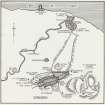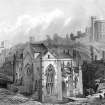Following the launch of trove.scot in February 2025 we are now planning the retiral of some of our webservices. Canmore will be switched off on 24th June 2025. Information about the closure can be found on the HES website: Retiral of HES web services | Historic Environment Scotland
Edinburgh, Leith Wynd, Trinity College Church And Hospital
Church (15th Century), Hospital (15th Century)
Site Name Edinburgh, Leith Wynd, Trinity College Church And Hospital
Classification Church (15th Century), Hospital (15th Century)
Canmore ID 52414
Site Number NT27SE 37
NGR NT 25993 73945
NGR Description NT 2599 7393 and NT 2605 7388
Datum OSGB36 - NGR
Permalink http://canmore.org.uk/site/52414
- Council Edinburgh, City Of
- Parish Edinburgh (Edinburgh, City Of)
- Former Region Lothian
- Former District City Of Edinburgh
- Former County Midlothian
In 1460 Mary of Gueldres founded Trinity College and Hospital in memory of her late husband, King James II. By 1585, the original buildings had deteriorated and the hospital moved into College buildings that had become redundant following the Reformation. In 1845 the hospital was still in use when it was demolished to make way for an extension to Waverley Station.
Information from RCAHMS (SC) 2 August 2007
Holmes, N M McQ 1988
NT27SE 37 2599 7393 to 2605 7388 removed to NT 2604 7373
For current (rebuilt) location, see NT27SE 224.
Trinity College. (RCAHMS 1951). This consisted of Trinity College church, Trinity Hospital, and the Manses of the Prebendaries. The college included a provost, 8 prebendaries and 2 cloisters, the priests being bound to make 'personal residence.'
Trinity College Church was founded in 1460 by Mary of Gueldres in memory of her husband James II and was dedicated to the Holy Trinity, the Blessed Virgin, St Ninian and All Saints It was begun in the lifetime of the foundress but operations were broken off in 1531, when only the choirs and transepts had been completed, and was not resumed. Queen Mary was buried in the Church. After the reformation the church fell to the Crown and was thence conveyed in 1567 to the Provost and Magistrates of Edinburgh. About 3 centuries later (ie. c.1867) the property was acquired by the North British Railway Company who, in spite of opposition, demolished the Church with the intention of rebuilding it elsewhere. But during a 30 year delay caused by litigation the unprotected stones were gradually robbed. (and the Church was never rebuilt).
The Manses of the Prebendaries were destroyed in 1558.
The Hospital, which was out of repair in 1576 was removed in 1585 to the site previously occupied by the Manses. The Church was situated in the hollow below the SW shoulder of the Calton Hill' where it immediately adjoined the Town Gate that was originally named after St Andrew but which latterly became known as Lith Wynd Port'. It occupied the site of a former Chapel of St. Ninian (which is wrongly sited by Arnot (1788) in 'The History of Edinburgh').
The Manses of the Prebendaries stood on the S side of the Church.
The Hospital stood originally on the opposite side of the street, facing the Manses. Church and Hospital are both illustrated on Gordon of Rothiemay's map of 1647.
(Sited as follows from Gordon of Rothiemay's map, dated 1647, (reprint in RCAHMS):-
Trinity College Church:- NT 2597 7394.
Manses of Prebendaries:- NT 2598 7393.
Hospital, pre 1585:- NT 2601 7393 - post 1585:- NT 2598 7393)
H Arnot 1788; RCAHMS 1951.
The site of St. Ninians Chapel is at the NW Corner of Regent Bridge. St Ninians Chapel was situated to the SE of the present Register Office. (Both these sitings appear to be rather north of the site indicated on Gordon of Rothiemay's map. They may be connected with the 'History of Edinburgh' siting which RCAHMS says is wrong.
Name Book 1852; NSA 1845; D Wilson 1891.
Similar information as above.
M E C Walcott 1874; D MacGibbon and T Ross 1896-7.
No traces of these buildings remain today. Most authorities tend to place the site of St. Ninian's Chapel a little north of the College Buildings; therefore it has been considered preferable to card this site separately. (please see NT27SE 67)
Visited by OS (J D) 26 December 1953.
St. Ninian's Chapel stood considerably further north of the Church (Trinity College Church) and its ruined walls disappeared in 1814 in clearing the ground for the erection of the Waterloo (now Regent) Bridge.
D Wilson 1884; Visited by OS (J D) 1 June 1954.
See also site NT27SE 224 for notes on Trinity College Church. The Church was removed stone by stone from this site, and rebuilt on its present site in 1848.
Antiquarian Observation (April 1836 - May 1845)
Publication Account (1951)
4. Trinity College Church.
This collegiate church was founded in 1460 by Marie of Gueldres, in memory of her husband James II, and was dedicated to the Holy Trinity, the Blessed Virgin, St. Ninian and All Saints. It occupied the site of a former chapel of St. Ninian,* in the hollow below the S.W. shoulder of the Calton Hill, where it immediately adjoined the town gate that was originally named after St. Andrew but which latterly became known as Leith Wynd Port. On its S. side stood the manses of the prebendaries facing, on the opposite side of the street, the Trinity Hospital, founded as another part of the same benefaction for the support of thirteen bedemen. The establishment, or college, included a provost, eight prebendaries and two choristers, the priests being bound by the terms of their appointment to "make personal residence and by themselves and not by another or others" to fulfil the obligations of their office - a provision calculated to prevent the evils of absenteeism from which both Church and State were then suffering. The construction of the collegiate church was begun in the lifetime of the foundress under the direction of Sir Edward Bonkill, the first provost, and John Halkerstone, master of the fabric; but when, in 1531, operations were broken off, never to be resumed, no more than the choir and transepts had been completed. The nave had not been begun, and of the nave aisles only a few stones had been laid. When Queen Mary died, in 1463, her obsequies were celebrated in Brechin Cathedral but she was laid to rest in the church that she had founded in Edinburgh. Accounts of the searches made on the site for her remains will be found in P.S.A.S., iv (1860-2), pp. 554-77.
The hospital, already out of repair in 1576, was removed in 1585 to the site previously occupied by the prebendaries' manses, which had been destroyed in 1558. Church and hospital are both illustrated in Gordon of Rothiemay's map of 1647, each standing in its own enclosure on the W. side of Leith Wynd and overlooking on the W. a garden down the middle of which runs a stream** having a dovecot on its N. bank. The smaller court is entered at the centre of the E. side by a gateway that is surmounted by a pyramidal spire with a cross; and from the gateway a two-storeyed range extends N. and S. along the E. side of the court and abuts on a short two-storeyed building occupying most of the N. side. On the S. side stands an oblong building of two storeys and an attic, which has a wing extending to the S. and, apparently, a round tower with a pyramidal roof projecting from the S.E. corner. A simple archway gives access from Leith Wynd to the larger enclosure, which the church, incomplete as it is, almost covers. The church itself has an apsidal-ended, aisled choir, shallow transepts, and a N. re-vestry. Above the crossing rises a tower, shown with a temporary couple-roof. From later drawings it appears that the W. crossing-arch was filled in with a screen wall, that all parts were covered with tierceron vaults, that the high roofs were slated, and that the re-vestry and aisles were stone-flagged. The entrance led through a porch into the S. aisle. Sir Daniel Wilson has probably given the most comprehensive account of the building.(1)
After the Reformation the church fell to the Crown and was conveyed with its endowments to the provost and magistrates of Edinburgh by a royal charter of 12th November, 1567 (2). This led, in the end, to its downfall, for some three centuries later, with the consent of the minister, the presbytery and the town council, the property was acquired by the North British Railway Company who proceeded, in 1848, to demolish the church to make way for the Waverley Station. A spirited protest against the demolition was entered by the Society of Antiquaries of Scotland, who had memorialised the provost and magistrates, as well as the Lords of H.M. Treasury, in 1844 (3); and although the protest was unsuccessful, as the parties immediately concerned had assented to the demolition, it did some good in that the operation was undertaken with some care, the individual stones being numbered on removal in correspondence with record drawings in order that the church might be rebuilt upon some other site. But unfortunately, as the result of a law-suit, the stones were suffered to lie unprotected for nearly thirty years on the Calton Hill, where they formed a convenient source of material for suburban rockeries. Some of the strays have since been gathered together and placed in Lady Stair's House (No. 15), while others are at the Astley Ainslie Institute (No. 205); the fragments of a 15th century Gothic window in the rockery at Craigcrook Castle (4) are likewise believed to have come from here.
RCAHMS 1951
(1)P.S.A.S., xviii (1883-4), pp. 128-70. (2) Laing, Collegiate Churches, p. xxviii. (3) Arch. Scot., iv, p.
448. (4) Inventory of Midlothian, p. 37.
*Arnot was wrong in believing that the remains described by him in The History of Edinburgh, p.248, were those of St Ninian’s Chapel, as they were evidently about 200 yards away from the chapel’s true position.
**This stream was the ‘torrent’ or ‘strand’ that carried off the overflow of the North Loch.
Field Visit (26 December 1953)
No traces of these buildings remain today. Most authorities tend to place the site of St. Ninian's Chapel a little north of the College Buildings; therefore it has been considered preferable to card this site separately. (please see NT27SE 67)
Visited by OS (J D) 26 December 1953.
Publication Account (1981)
Trinity Church was founded by Mary of Gueldres, widow of James II, and stood on the site now largely occupied by Waverley Station. On its south side stood the manses of the prebendaries and standing opposite was the hospital, Trinity House, founded as part of the same benefaction for the support of thirteen poor people (RCAM, 1951, 36). The church consisted of a choir with north and south side aisles, north and south transepts, but no nave. It is assumed that the death of the foundress in 1463 hindered progress on the structure (MacGibbon and Ross, 1896, iii, 89-90). In 1848, the church was carefully demolished stone by stone to make way for Waverley Station and as it was intended to rebuild the structure, each stone was diligently numbered (Gray, 1940, 55). Alas, the stones lay dormant for years in Regent Road, and only a small number were used in constructing the hall of Trinity Church in Jeffrey. Street in 1872.
Information from ‘Historic Edinburgh, Canongate and Leith: The Archaeological Implications of Development’ (1981).














































